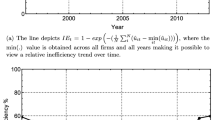Abstract
This paper uses a non-parametric frontier model and adaptations of the concepts of cross-efficiency and peer-appraisal to develop a formal methodology for benchmarking provider performance in the treatment of Acute Myocardial Infarction (AMI). Parameters used in the benchmarking process are the rates of proper recognition of indications of six standard treatment processes for AMI; the decision making units (DMUs) to be compared are the Medicare eligible hospitals of a particular state; the analysis produces an ordinal ranking of individual hospital performance scores. The cross-efficiency/peer-appraisal calculation process is constructed to accommodate DMUs that experience no patients in some of the treatment categories. While continuing to rate highly the performances of DMUs which are efficient in the Pareto-optimal sense, our model produces individual DMU performance scores that correlate significantly with good overall performance, as determined by a comparison of the sums of the individual DMU recognition rates for the six standard treatment processes. The methodology is applied to data collected from 107 state Medicare hospitals.
Similar content being viewed by others
References
R.C. Camp, Benchmarking: The Search for Industry Best Practices that Lead to Superior Performance (ASQC Quality Press, Milwaukee, 1989).
S.F. Jencks and G.R. Wilensky, The health care quality improvement initiative: A new approach to quality assurance in medicine, Journal of American Medical Association 268 (1992).
C. Kiefe, T.W. Woolley, J.J. Allison, J.B. Box and A.S. Craig, Determining benchmarks: A data-driven search for the best achievable performance, Clinical Performance and Quality Health Care 2(4) (1994) 190–194.
C. Kiefe, N.W. Weissman, J.J. Allison, R. Farmer, M. Weaver and D. Williams, Identifying achievable benchmarks of care: Concepts and methodology, International Journal for Quality in Health Care 10(5) (1998) 443–447.
N.W. Weissman, J.J. Allison, C. Kiefe, R. Farmer, M. Weaver, D.Williams, I. Child, J. Pemberton, K. Brown and C.S. Baker, Achievable benchmarks of care: The ABCTMs of benchmarking, Journal of Evaluation in Clinical Practice 5(3) (1999) 269–281.
L. Schrage, Optimization Modeling with Lindo, 5th Ed. (Duxbury Press, Pacific Grove, 1997) pp. 408–409.
R.E. Stanford, Benchmarking medical treatment processes, in: San Diego INFORMS Spring Meeting, SB04.1 (1997).
L.E. Caporaletti, J.H. Dula and N.K. Womer, Performance evaluation based on multiple attributes with non-parametric frontiers, Omega 27 (1999) 637–645.
D. Bouyssou, Using DEA as a tool for MCDM: Some remarks, Journal of the Operational Research Society 50 (1999) 974–978.
P.P. Sutton and R.H. Green, A data envelopment approach to decision analysis, Journal of the Operational Research Society 53 (2002) 1215–1224.
J. Doyle and R. Green, Data envelopment analysis and multiple criteria decision making, Omega 21(6) (1993) 713–715.
V. Belton and S.P. Vickers, Demystifying DEA: A visual interactive approach based on multi-criteria analysis, Journal of the Operational Research Society 44 (1993) 883–896.
T.J. Stewart, Relationships between data envelopment analysis and multi-criteria decision analysis, Journal of the Operational Research Society 47 (1996) 654–665.
A. Charnes, W.W. Cooper and E.L. Rhodes, Measuring the efficiency of decision making units, European Journal of Operations Research 2(6) (1978) 429–444.
A. Charnes, W.W. Cooper and E. Rhodes, Short communication: Measuring the efficiency of decision making units, European Journal of Operations Research 3 (1979) 339.
A. Charnes, W.W. Cooper, A. Lewin and L.M. Seiford, Data Envelopment Analysis: Theory, Methodology and Applications (Kluwer Academic, Boston, 1994).
W.W. Cooper, L.M. Seiford and K. Tone, Data Envelopment Analysis: A Comprehensive Text with Models, Applications, References, and DEA Solver Software (Kluwer Academic, Boston, 2000).
L.M. Seiford, A cyber-bibliography for data envelopment analysis: 1978-1999, contained on the CD accompanying Data Envelopment Analysis: A Comprehensive Text with Models, Applications, References, and DEA Solver Software, by W.W. Cooper, L.M. Seiford and K. Tone (2000).
J.A. Chilingerian and H.D. Sherman, Benchmarking physician practice patterns with DEA: A multi-stage approach for cost containment, Annals of Operations Research 67 (1996) 83–116.
J. Chilingerian, Evaluating physician efficiency in hospitals: A multivariate analysis of best practices, European Journal of Operational Research 80 (1995) 548–574.
J.M. Bates, D. Baines and D.K. Whynes, Measuring the efficiency of prescribing by general practitioners, Journal of the Operational Research Society 47 (1996) 1443–1451.
Y.A. Ozcan, Physician benchmarking: Measuring variation in practice behavior in treatment of otitis media, Health CareManagement Science 1(1) (1998) 5–18.
R.E. Stanford, Benchmarking medical treatment processes, Working Paper 2001-1, Center for Outcomes and Effectiveness Research and Education, University of Alabama at Birmingham (2001).
J. Mant and N. Hicks, Detecting differences in quality of care: The sensitivity of measures of process outcomes in treating myocardial infarction, British Medical Journal 311 (1995) 793–796.
A. Charnes, W.W. Cooper, Q.L. Wei and Z.M. Huang, Cone ratio data envelopment and multi-objective programming, International Journal of Systems Science 20(7) (1989) 1099–1118.
R.L. Keeny and H. Raiffa, Decisions with Multiple Objectives: Preferences and Value Tradeoffs (Wiley, New York, 1976).
M. Zeleny, Multiple Criteria Decision Making (McGraw-Hill, New York, 1982).
T.R. Sexton, R. Silkman and A. Hogan, Data envelopment analysis: Critique and extensions, in: Measuring Efficiency: An Assessment of Data Envelopment Analysis (Jossey-Bass, San Francisco, 1986).
J. Doyle and R. Green, Efficiency and cross-efficiency in DEA: Derivations, meanings, and uses, Journal of Operational Research Society 45(5) (1994) 567–578.
L. O'Neill, Multifactor efficiency in data envelopment analysis with an application to urban hospitals, Health Care Management Science 1 (1998) 19–27.
L. Friedman and Z. Sinuary-Stern, Combining ranking scales and selecting variables in the DEA context: The case of industrial branches, Computers and Operations Research 25(9) (1998) 781–791.
M. Braglia and A. Petroni, A quality assurance-oriented methodology for handling trade-offs in supplier selection, International Journal of Physical Distribution and Logistics Management 30(2) (2000) 96–111.
P. Anderson and N.C. Petersen, A procedure for ranking efficient units in data envelopment analysis, Management Science 39 (1993) 1261–1264.
A.I. Ali, Streamlined computation for data envelopment analysis, European Journal of Operations Research 64 (1993) 61–67.
T. Coelli, D.S. Prasada Rao and G.E. Battese, An Introduction to Efficiency and Productivity Analysis (Kluwer Academic, Boston, 1999).
H.O. Fried, K. Lovell and S.S. Schmidt, The Measurement of Productive Efficiency: Techniques and Applications (Oxford University Press, Oxford, UK, 1993).
Author information
Authors and Affiliations
Rights and permissions
About this article
Cite this article
Stanford, R.E. A Frontier Analysis Approach for Benchmarking Hospital Performance in the Treatment of Acute Myocardial Infarction. Health Care Management Science 7, 145–154 (2004). https://doi.org/10.1023/B:HCMS.0000020654.69499.50
Issue Date:
DOI: https://doi.org/10.1023/B:HCMS.0000020654.69499.50




